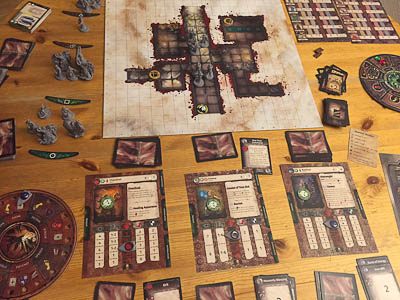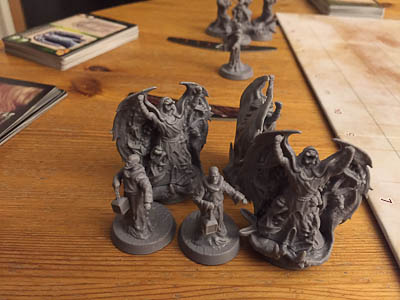

![[IMAGE]](../bilder/perdit1.jpg) |
Authors: Publisher: No. of Players: Awards: |
![[IMAGE]](../technik/box/rot/rot-8.gif) ![[IMAGE]](../technik/box/gelb/gelb-8.gif) ![[IMAGE]](../technik/box/grun/grun-7.gif) ![[IMAGE]](../technik/box/pink/pink-7.gif) ![[IMAGE]](../technik/box/blau/blau-9.gif) |
|
Gamebox author Ralf Togler writes about the game:
How should I begin a review about a game that was announced as the heaviest game at SPIEL 2016? Well, I guess it is best to begin with its actual weight: nearly 4 kg says my weighing scale. To compare this I have some other weights for you: Zombicide: 2,3 kg Conan: 3,5 kg Dominion: 1,3 kg. With this weight, you should expect many components and indeed, the big game box is packed up to its limit. There is even no room for storage boxes for the more than 40 miniatures, so you have to put them in plastic bags and find a free corner in the box. The first few times this really hurt, but up to now no miniature was damaged and I also have not painted them yet (although I guess that would look pretty cool). The main reason for the weight however, are the four double-sided maps of the game. While some other games save on quality, the maps of Perditionís Mouth are huge and solid and they are a real eye catcher on the table. A lot of cards, map and scenario tokens references as well as some other game materials round off the rich and high quality components.
 Perditionís Mouth is a cooperative dungeon crawl board game, in which a group of 1 Ė 6 heroes must discover a system of caverns. A strange cult has gathered these caverns to worship and summon a mighty demon. Of course, this would be no good for humankind and so it is up to us again to get rid of all the acolytes, summoners, nasty insects, minor demons and other strange creatures to prevent the summoning. The game is scenario-based, with the core game consisting of one campaign with 6 single scenarios. Before we can enter the dungeon, the map must be set up as the scenario tells us. Each scenario uses its own map, so there is a lot of variation from one scenario to the next. Another advantage is that the mass of game elements is introduced step by step. This applies for the different kind of enemies, each with its own movement and combat rules as well as for the map specialities. So the complex terrain rules that influence the movement, attacking and defending values, as well as line of sight, can more or less be ignored in the first scenarios. Maps are comparable empty off enemies at the beginning of a scenario, a condition that will change soon in the game. So what seems to be quite easy at the beginning (for example crossing a room of the dungeon) becomes tricky, when more and more enemies spawn on the board. Let me say you that Perditionís Mouth is definitely no simple Hackín Slay game. If you think you can push forward your hero to rage by your own, you will soon be defeated.  That leads us to the heroes, one of the highlights of Perditionís Mouth. Each hero comes with his individual hero sheet and cards. These cards are the players skills to move, fight, cast spells and can often be used in several ways. Depending on the hand limit of the hero a specific number of cards go into your hand. Cards spent in either of the possible ways find their way to a discard pile. If a player is allowed to draw new cards he does so from the draw pile until a player chooses to rest, which allows him to shuffle all discarded cards back into his draw pile. During the game other cards find their way into the deck of a hero: positive cards for example as a reward from the scenario as well as wounds that only block your hand cards. While playing a campaign, positive as well as negative cards must be taken from one scenario to the next. The abilities of the heroes differ a lot, so each hero must be played differently. In contrast to a lot of other games it is nearly impossible to turn a sorcerer into a knight. If you choose a wizard you better stay away from melee combat. The reason for this are the different attribute values (action points, range, attack and defence) and the powers of the totally different cards. It is extremely important to bring the best out of your hero and to aid other heroesí actions. The latter is possible if you have cards with a matching action symbol and if you are not to far away from your fellow players, because aiding from a distance is less effective. As a result, it is very wise to stay as a group. To choose an action ,a player has to move his hero peg from one spoke to another on a rondel, called the Stone of Destiny. This contains eight spokes for the different actions, but a player may only choose a spoke, if there is still a free peg hole for his hero. If all holes are occupied, the hero peg must be moved further on the Stone of Destiny, before using the remaining movement points for the action, for example the movement on the board. Most of the actions have optional steps, so for example in a charge you can spend action points to move your hero on the board and after that make one attack. As there is no fixed order to activate the heroes, players should co-ordinate their actions to prevent a heroís peg must from moving too far on the Stone of Destiny or hinder a wounded hero to rest, because the rest spoke is occupied by another playerís peg.  Playing cards with matching action symbols can boost all actions. For example let us say that a hero has four action points: first he moves his peg one spoke on the Stone of Destiny to the spoke of the move action. With the remaining three action points he moves his hero's miniature on the board and finally he plays a card with the move symbol to move the hero two steps further. Once a hero is close enough (within range) he may attack creatures of the dungeon by choosing an action that allows him so (attack, charge, aimed shot and some special actions of the heroes). Again this action can be boosted by cards from your hero and the help of your fellow players, but the base attacking points are given by the heroís sheet. Being wounded will influence all of your attributes, so you get weaker and slower. Each type of enemy has its own defence value that is modified by drawing a response card from a response deck. To kill an enemy, more hit points must be dealt to it than its current life points. Minor enemies can be killed by just one hit, but in the advanced scenarios, enemies withstand three or more wounds. After all heroes had their turn, it is time for the enemies. First of all, an enemy marker is moved forward on the Enemy Watchstone, again a rondel that tells us if enemies move, attack or if new enemies are spawned. A card from the response deck is drawn that determines how many steps the marker moves. If it says to move more than one step, enemies take multiple actions in a round, so it is difficult to precisely know what will happen. Enemies always move towards the closest hero, in case of a tie, they move towards the weakest hero. Knowing this, players can lead enemies to stronger heroes, but sometimes enemies approach from different directions and so a hero group might be encircled. Sometimes the movement rules end in some very odd and nonsensical moves of the enemies, but in most situations this works pretty well.  Once the marker on the Enemy Watchstone is moved on an attack spoke, all enemies within range attack the heroes. If an enemy can attack more than one hero, it attacks the weakest first, so again it is wise to give those heroes shelter. Enemy attacks are resolved similar to hero attacks. The only difference is that the response card now counts for the attacking value and a player must play defending cards to boost his natural defence. Next to the physical damage, which results in reducing attributes and drawing wound cards on top of the hero deck, some enemies have poisonous attacks that reduce the available action points of a hero. There are a lot of other features I cannot explain in detail in this review like the opening of doors, picking locks, terrain specifications, treasures and victims. In the end that makes Perditionís Mouth a rather complex dungeon crawl game. But as these components are introduced step by step, it is not difficult to start the game.  Perditionís Mouth was really a joy to play. Other than expected, the game is deeply tactical and stretches the players to their limits. The campaign that comes with the core game is long enough to keep a group of players busy for some time. Each scenario is different, some are easier and more interesting than others. Some of the scenarios could need some revision, but basically they all work well (although not with every hero combination). Of course it is best, when playing the campaign, but it is also possible to choose a single scenario. The game can be played solo, but although the difficult level and the number of enemies is adjusted, it is quite hard to win a scenario with only a single hero. Aiding is much more important than most players think at the beginning. Besides a scenario can be won with one or more dead heroes (although they cannot be used for following scenarios afterwards, if you play a campaign). Maybe you have wondered why I didn't talk about dice. The reason for this: there are none. Playing a dungeon crawl game without a dice is really a new feeling, but it works pretty well. The element of chance is introduced by the response deck, but with progressing time the results become more and more predictable (because you already know which cards have already been drawn). The publisher tells us that the game is a Euro game and indeed it is. I like Zombicide a lot, but Perditionís Mouth is much more luck-independent and tactical. In the advanced scenarios there are some very tricky tactical puzzles and next to precisely predict and foresee the enemies movements, it is also important to get the best out of your heroes. So, if you know the game better, it is even worth spending some discussions on how to best compose your hero group. Perditionís Mouth gives the players many options to modify the difficult level. For example, you can make the response deck more or less difficult by adding stronger or weaker cards to the standard ones. So each dungeon crawling player should find a way to love the game. For me, it is currently one of the best modern dungeon crawl games with a strong theme and an entertaining story-telling campaign. Of course this deserves a G@mebox star. | ||
|
| ||

|
|

|
|
| ||
|
Impressum / Contact Info / Disclaimer Kulkmann@aol.com
Copyright © 2017 Frank Schulte-Kulkmann, Essen, Germany | ||